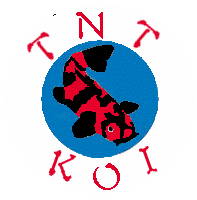


|
For Sale |
you have? Koi Types |
for the first time? |
|
|
|
|
|
Koi And Koi Ponds Shipping Koi Information Koi Food Koi Ponds & Water Gardens Water Conditioners Filters Pumps Ultraviolet Sterilizers Pond Accessories Pond Plants Check Out Our Clicking Here 
. . . . . . . . . . . . |
. How do I know if my fish is a male or female? Until the fish are about 10 to 12" it is extremely difficult to sex them. Even then, mistakes are made. As a general rule, males are more streamlined and slender. Females on the other hand are more rounded in body. If you can observe them while spawning you will see the larger female being chased by the more slender male. . What color will my fish be? Fish can change color almost at any age. The colors can become deeper, lighter, or change altogether. It varies from fish to fish. Some will stay close to the original colors their whole life and others will completely change. . How much do I feed them? Little and often is the general rule. If you are interested in hand feeding your fish, they will become bolder and tamer when they have worked up an appetite. If, after ten minutes or so, there is uneaten food still floating on the pond, you should take it out. After a few times you will be able to judge about how much to feed at a time. Koi can go for 10 or more days without food without harm. They will eat almost anything but we feed them pellets that are specially made for Koi. These pellets come in different sizes and varieties. Koi can also be fed dried or fresh shrimp, lettuce cooked rice or cooked oats. . What about feeding in the colder weather? When the pond temperature gets down to 50 degrees you should stop feeding them. By this, I mean only feed them once or twice a week instead of two or three times a day. Also it is a good idea to feed them wheat germ or other low protein food. They will still come to the side and look at you with those hopeful eyes but it is dangerous to feed them the same when the temp is so low. The food just sits there inside them and rots as their metabolism cannot handle food at low temps. . How big do they get? The average Koi can grow to 24 - 36 inches! The size of the pond, the amount of aeration, and feeding methods will affect the growth of the fish. It is not uncommon for a small Koi to grow 2 - 4 inches a year in a backyard pond. . How long do they live? Maximum life span is over 200 years in exceptional cases; average life span is more like 25 to 35 years. . How do I introduce my new fish into my pond? After transporting Koi, float the bag (unopened) in the water for about 30 to 45 minutes to allow the water temperature inside and outside the bag to equalize before releasing the Koi. Koi can withstand a wide range of temperatures, however sudden changes in temperatures are not good for them. When introducing new Koi to your pond, be careful that they don't jump out, especially near the waterfall. Remember that stress is a major cause of Koi deaths. Stress may result from changes in pond conditions, over handling, over medication, etc. . What about breeding? Koi are not live bearers but lay thousands of eggs in a single breeding. Koi must be at least 3 to 4 years old and of sufficient size before they breed. Koi require special water conditions and environment for breeding. The eggs and baby Koi must be separated from the adult Koi or they will more than likely be eaten. The baby Koi hatch in about 3 to 7 days depending on the weather. The survival rate for baby Koi is less than 50%. . How is the selling price determined? Selling price of Koi is determined by size, body shape, color, pattern, and availability. . Do Koi get along with goldfish or other tropical fish? Koi get along well with goldfish or other tropical fish as long as the other fish aren't aggressive or small enough to eat. . Will my fish die in winter in a outdoor pond? Koi can survive under the ice in extreme cold as long as the water does not freeze solid. Koi will not move around or eat much if the pond water is very cold. Some individual fish just inexplicably die, but overall, Koi are remarkably hardy and healthy fish; much more so than goldfish or tropical fish. Just be sure to have an opening in the ice covering your pond so that no harmful gases build up. . .
|
|||||